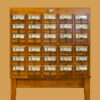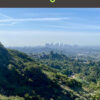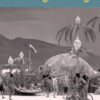On January 6, Karen and I at last got to see the Buffalo Dance in the snow at Taos Pueblo. There’s always an animal dance on the Christian feast day of Epiphany, but if there’s no snow it’s likely to be a Deer Dance, because it is said traditionally around the pueblo that the buffalo bring the snow with their stomping. The buffalo are special. The Taos people haven’t hunted them for almost a century, but they still associate the hard, starvation-staving winter trip hunters used to make, sometimes eastward into Texas, with the padres’ story of the three Magi, and they call the celebration Kings Day. In dutiful preparation, they briefly repopulate the powerfully paired, nearly abandoned adobe buildings dating from the mid-fourteenth century that frame and structure the performance.
Seasonal weather and daylight set emotional tone in Northern Pueblo dances, and the impresarios of Taos are masters of timing and low-tech stagecraft. I observed their expertise in theatre lighting once on a golden October afternoon at the start of the Vespers Dance performed only by old men and women packed inside the little churchyard on the feast day of San Geronimo, the village patron. That dance was delayed well past the advertised time, and, as I waited for it to start, my tourist self grew increasingly worried that I would miss the last plane out of Albuquerque. The dance manager was clearly aware of the tension he was creating in the audience as, with patient precision, he let the lowering sun reach the correct angle to produce its maximum dramatic effect and also, perhaps, to remind dancers and onlookers of a ritual confluence of cosmic and animal/human dynamics. At just the right moment, the latter takes over from the former and, at an unseen signal, the silverhaired dancers hold aloft quivering yellow aspen branches that catch the raking light and ignite into a dazzling visual fire cloud—a breathtaking contradiction to the quiet, shuffling dance itself.
The pueblo website had billed the much longer Buffalo Dance as starting “tentatively” at 2:00 p.m. But we had learned at a curio shop in the town square that it had been moved an hour earlier, to keep it as bright and unsentimental as possible, I guessed, and it was getting colder.
We drove over, parked our car, and paid the modest entry fee. The plaza seemed almost empty. We watched as an uncostumed man hurriedly strewed what would be the dancer’s path with fresh, gold-green straw, marking and enlivening the dull-looking surface. (Later the straw would hold the mud together, improving their footing.) Just then, dancers from the south building could be seen in the distance, descending from the roofs of their kivas. After some bantering and a brief warm-up, they crossed the creek that halves the pueblo, filing over the narrow log bridge at the far end of the plaza to pick up a smaller group that had emerged from the kivas of north building. We counted about forty buffalo in all; young men, old men, fat men, little boys—naked except for red body grease, plain kilts, and high-cut moccasins (these very wet) with, huge, horned, eyeless buffalo heads uncomfortably balanced on their own. There were also three sad-looking deer, five or so hunters, a hunt mistress (I think) and eight drummer/singers. Choruses of women ululated loudly to excite the buffalo at the start of each movement. They danced seven formal sets and a few informal ones at the beginning and end. It was all remarkably similar to Vincent Scully’s vivid explication of the 1974 performance in his study, Pueblo: Mountain, Village, Dance.
The architect’s eye finds the route the dancers follow around the northern half of the great square to be symbolic and functional, freighted with iconography and tribal politics but also responsive to performance requirements for dramaturgy and acoustics. Over the course of the dance, the herd moved from the low east wall that signifies a separation between the built pueblo and the sacred mountain’s animal world, across to the opposing church (modernity perhaps, the White Man’s god?) and back.
They stopped to dance three times before and after the church set, always staying close to the north building, which gives an acoustic throw to the small chorus of women off its dense, adobe walls and provides elevated source positions for their high-pitched cries. The drumming, on small, hand-held drums, was gentle compared with other dances we’ve attended, but its sound, too, was strong and bright. It looks as if the different responses of bass and treble wavelengths have long been understood and choreography adjusted accordingly.
We found the formal simplicity of this winter dance to be deceptive. The guidebooks are not much help, often flatly labeling it as being about “abundance,” but clearly there’s more to it than that. You can’t mistake a general concern with unity and communal strength, and there appear to be key elements denoting vision and leadership. Looking at the range of minor characters, I found it easy to imagine layers of moral complexity, but that may have more to do with my own Protestant conditioning than with animist reality.
The overall message must be happy and reassuring, because the event cheers the whole village even in the cold, penetrating damp of a gray New Mexico winter’s day. Between movements, the buffalo graze aimlessly. Suddenly, in response to a louder drumbeat and the women screeching, they stomp their right feet with the beat hard on the muddy ground, whirling then filing. I’m sure the dancers can’t see well (so that the buffalo can), and it looks impossibly exhausting. The buffalo sweat and steam, but somehow they all keep dancing for almost two hours. The dancers’ rhythm grows more precise as, gradually, they abandon humanity to become animals, working hard to invoke the power of their animal world. In the end, finally separated, the north and south groups compete to see which will outlast the other, dancing informal sets by their kivas. The old song becomes antiphonal.
When it’s over, the steaming dancers unload their heavy heads and double up with exhaustion, happy and perhaps relieved but clearly proud of what they have accomplished for the community. It’s all much more primitive and scary than the mostly agricultural dances of the rest of the year. Commercial it is not. No cameras, no cell phones, and big, tough-looking guys making sure of it. About sixty cold-looking, non-Indian people attended. When it ended, none of us knew quite what to do.
Author Barton Phelps, FAIA, links his internationally recognized Los Angeles architectural practice with teaching and writing about built landscapes. As chair of the AIA Committee on Design, his yearlong symposium series, Changing American Landscapes: The View from the River, surveyed regional patterns of spatial use and meaning in the Mississippi River valley.
Originally published 4th quarter 2010, in arcCA 10.4, “Faith & Loss.” Re-released in arcCA DIGEST Season 08, “Indigeneity.”
Cover image, Ansel Adams, “Church, Taos Pueblo National Historic Landmark, New Mexico, 1942,” licensed under CC BY 2.0.





